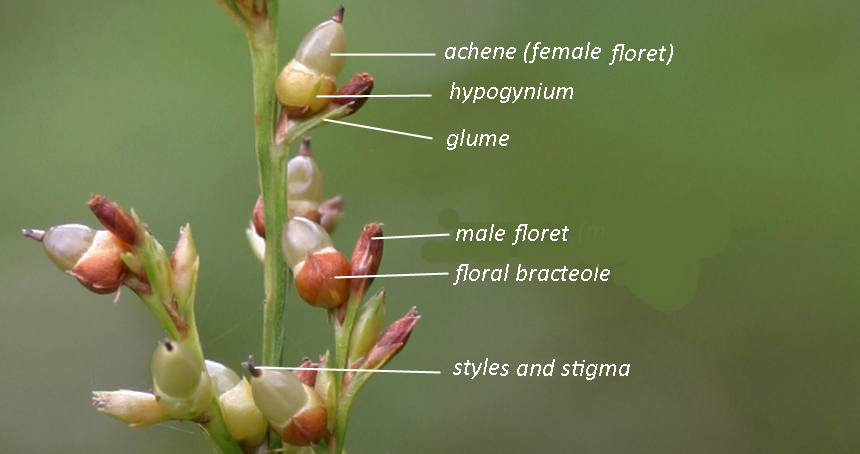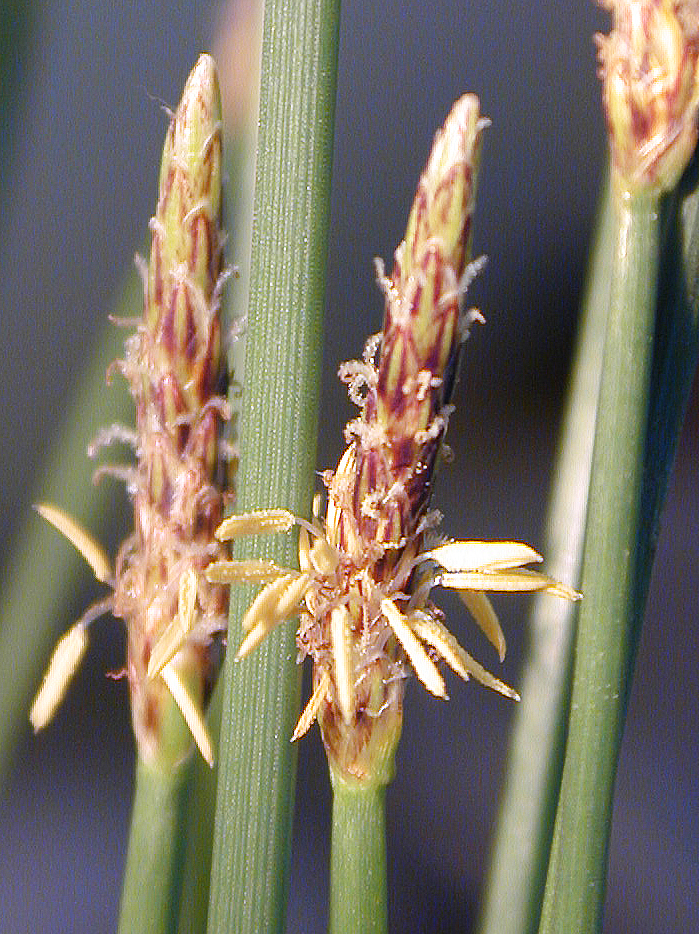|
Like grasses (see grass flower page), sedges have small flowers or florets that lack showy petals. But they also lack the surrounding bracts of the grass floret termed "palea" and "lemma". Rather, a single, small bract or bracteole subtends (is attached below) each floret. A floret and bract alone may constitute a spiklelet, or may be combined with other florets into a spikelet (see below). In the latter, each floret is typically obscured by its bract. The term glume is applied somewhat loosely to any of the bracts that occur beneath the floret.

In the photograph at left of Scleria testacea spikelets, each spikelet has but a single floret with a bracteole. The flowers are unisexual (either male or female; flowers are imperfect), so that details of the female floret, at least, are readily observable. This species is monoecious, meaning both male and female flowers occur on the same plant. In this Scleria (a species not found on Guam), the uppermost or terminal floret of each "partial panicle" is pistillate (female). The hypogynium is a cup-like or scale-like structure that surrounds the ovary. The fertilized ovary develops into a fruit called an achene; those shown here are about 2 mm across.

The two spikelets of Eleocharis dulcis (water chestnut) shown in the photograph at the right are displaying anthesis, when the (male) stamens and (female) stigmas are exserted from the floral bracts. Stamens are the prominent yellowish structures extending outward along the lower third of the spikelet—in this case 1 per floret but in some species up to 3. The styles (3 per stigma, in some species 2) are the whitish feathery structures especially evident here in the middle of the spikelet. In this sedge, a spikelet is composed of numerous florets, the floral bracts arranged spirally around the rachis. At anthesis, pollen grains are released from the stamens and distributed by the wind to be captured by the styles, thus fertlizing the ovary of the floret.
As noted above, florets are grouped within a structure called a spikelet (Figures M and N). The spikelet is a basic floral structure, but is less important in sedge taxonomy than is the case for grass taxonomy. Just as in grasses, a sedge flowering structure (the inflorescence) consists of numerous spikelets arranged in a particular manner at the upper end of a vertical stem called the culm (or axis or peduncle within the inflorescence). In sedges the spikelets can be attached directly to the culm or attached at the ends of small stalks called pedicels. If branched, the terms branch or ray may apply to the part supporting multiple pedicels.
Observing the structure of the infloresence is usually necessary for identifying a sedge species. Fortunately, it is generally the case that not only is the inflorescence easily seen in most sedges, but is nearly always present. One reason for this is that most sedge "plants" are actually part of a single plant growing from a common rhizome, so all ages of plantlets may be represented. Also, sedges tend to grow in wetter environments than grasses, so seasonality is less of a factor in determining flowering. A strategy employed by many grasses is to produce a lot of vegetative parts in the wet months, then start flowering as conditions start to shift to a drier state.
|